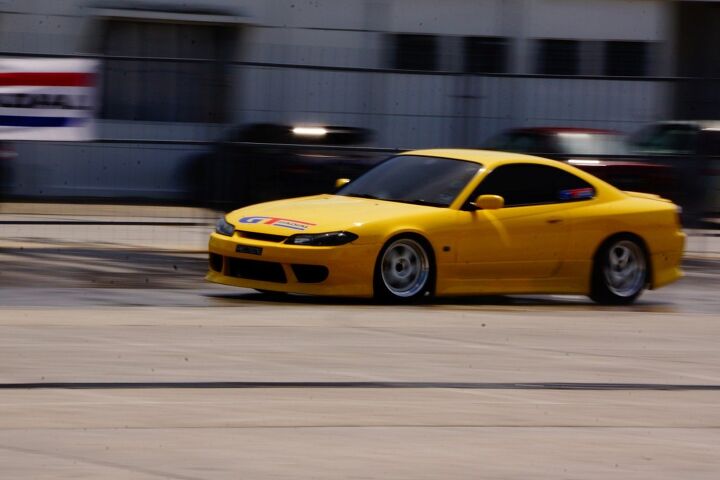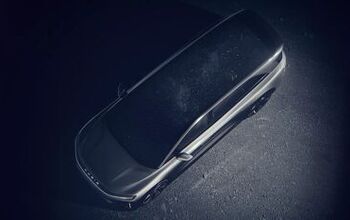Capsule Review: Nissan Silvia "S15"

It’s hard for me to be impartial about the Nissan Silvia: my first car was a 1983 200SX five-speed. I thought it was the coolest car ever. Unfortunately, I totaled it the very first time I drove it without adult supervision. (The story of that mishap, and its aftermath, can be read here.) I still think the 200SX and its successors are pretty cool cars. Nissan stuck with the rear-wheel-drive compact coupe formula for a full nineteen years after Toyota compromised on the Celica.
Nissan’s reputation with the Silvia in America was marred by two unhappy decisions. The first was to saddle the S13 and S14 generations of the car with the truck engine from the Nissan Pathfinder instead of the superb turbocharged variant of the SR20DE engine from the Infiniti G20 and the Nissan SE-R. As a result, the “240SX” never really got full credit for sporting intentions in a world where the Celica offered a turbo and the Prelude offered a series of sublime, high-revving, short-stroke engines. The second decision was to keep the sleek S15 at home. The final Silvia, with its “blacktop” SR20DET, lives with the R34 Skyline GT-R in the imaginations of Pocky-chomping weeaboo basement-dwellers everywhere.
Sadly, your humble author is a bit of a Pocky-chomping weeaboo basement-dweller when it comes to home-market Japanese cars, so when I happened to see a tuned-up S15 during my recent trip to the Sepang International Circuit, I threw an authentically American temper tantrum until they let me drive the thing.
The Silvia was there to promote the new Champiro SX2 tire from GT Radial, which is an Indonesian-based tire company primarily known in the United States for inexpensive truck tires. In Southeast Asia, however, the company fields a full slate of products including the aforementioned Champiro SX2, which is best described as a cross between an Eagle F1 Asymmetric and a Michelin PS2 sold for half the price of either. The GT Radial folks had set up a pair of slaloms, one wet and one dry, and connected them with a wide-radius left-hander. It was on this little course that I’d be running the S15.
As you’d expect from a turn-of-the-millennium Japanese coupe, the Silvia’s interior is a featureless expanse of blackish plastic and silverish accents, but there’s a trio of eyeball vents above the center stack to liven things up. It’s the kind of dash that could be easily used for both right-and-left-hand-drive applications, but in fact the S15 was never sold as anything other than a right-hand-drive car.
I don’t have a lot of experience driving RHD cars — this Nissan was only the third stick-shift car I’d ever driven with the wheel on the Imperial side — so it was a relief to find that the six-speed manual was easy and precise to operate. With 250 horsepower to push about 2900 pounds, the Silvia launches with respectable but not overwhelming force. The gearing’s short so I’m able to grab second before the first gate in the slalom. This car was never sold side-by-side with the 350Z, but it wouldn’t have threatened the more expensive coupe in any measure of straight-line performance.
Where the S15 scores over the Z is in the relatively low, wide hoodline and outstanding visibility. The Z33 always betrayed its sedan roots to me in the sheer height and mass of its dashboard/firewall assembly, which combined with the mail-slot windows to make the car a little claustrophobic. The Silvia, on the other hand, is pleasant and sporty-feeling. It’s a small car by modern standards, but it feels even smaller to drive, something like an E36 coupe. It hustles through the relatively narrow gates with aplomb and reveals precise, quick steering.
The aftermarket suspension fitted to this car flatters it a bit, but the fundamentals of the platform are absolutely sound. It’s a shame to think of all the S15s that are being chopped up to donate their blacktop engines to American 240SXes, but the Japanese don’t like to keep their old cars around anyway. Double shame, really, because the closest thing we have in either the United States or Japan to the Silvia is the FR-S. The FR-S is a more intimate and direct experience than the Silvia, but the two-liter boxer in the Toyobaru isn’t a patch on the SR20DET. In fact, the easiest thing Toyota could to do improve the FR-S would be to buy all remaining stock of the Nissan turbo engine and put in said FR-S, regardless of how gauche of a hood bulge would be required to make it fit.
Although my time with the Nissan was limited to about fifteen fast minutes, I’m thoroughly convinced that it would have been at least a moderate success in the United States. It’s spacious enough, fast enough, attractive enough. It would have made a great Infiniti, the same way the Skyline sedan and coupe that followed it into the market made great Infinitis. It was a casualty of the sedan-centric Nissan marketing philosophy that significantly damaged the company’s enthusiast following in the United States. A shame, really.
The S15’s lack of availability on these shores helped buff its reputation in some circles beyond anything the actual car could possibly match in the metal. In truth, the Silvia is simply a very pleasant Japanese coupe that would have found it slightly difficult to keep up with a New Edge Mustang in most situations. Pleasant Japanese coupes have been in short supply in the past fifteen years, however, so you’ll excuse me for waxing a bit nostalgic about this one. Given the choice between this and a Z, I’d choose the Silvia without hesitation. I’d just have to make sure I didn’t crash it!
Photography courtesy Bobby Ang/Wheels Weekly

More by Jack Baruth
Latest Car Reviews
Read moreLatest Product Reviews
Read moreRecent Comments
- Lou_BC "That’s expensive for a midsize pickup" All of the "offroad" midsize trucks fall in that 65k USD range. The ZR2 is probably the cheapest ( without Bison option).
- Lou_BC There are a few in my town. They come out on sunny days. I'd rather spend $29k on a square body Chevy
- Lou_BC I had a 2010 Ford F150 and 2010 Toyota Sienna. The F150 went through 3 sets of brakes and Sienna 2 sets. Similar mileage and 10 year span.4 sets tires on F150. Truck needed a set of rear shocks and front axle seals. The solenoid in the T-case was replaced under warranty. I replaced a "blend door motor" on heater. Sienna needed a water pump and heater blower both on warranty. One TSB then recall on spare tire cable. Has a limp mode due to an engine sensor failure. At 11 years old I had to replace clutch pack in rear diff F150. My ZR2 diesel at 55,000 km. Needs new tires. Duratrac's worn and chewed up. Needed front end alignment (1st time ever on any truck I've owned).Rear brakes worn out. Left pads were to metal. Chevy rear brakes don't like offroad. Weird "inside out" dents in a few spots rear fenders. Typically GM can't really build an offroad truck issue. They won't warranty. Has fender-well liners. Tore off one rear shock protector. Was cheaper to order from GM warehouse through parts supplier than through Chevy dealer. Lots of squeaks and rattles. Infotainment has crashed a few times. Seat heater modual was on recall. One of those post sale retrofit.Local dealer is horrific. If my son can't service or repair it, I'll drive 120 km to the next town. 1st and last Chevy. Love the drivetrain and suspension. Fit and finish mediocre. Dealer sucks.
- MaintenanceCosts You expect everything on Amazon and eBay to be fake, but it's a shame to see fake stuff on Summit Racing. Glad they pulled it.
- SCE to AUX 08 Rabbit (college car, 128k miles): Everything is expensive and difficult to repair. Bought it several years ago as a favor to a friend leaving the country. I outsourced the clutch ($1200), but I did all other work. Ignition switch, all calipers, pads, rotors, A/C compressor, blower fan, cooling fan, plugs and coils, belts and tensioners, 3 flat tires (nails), and on and on.19 Ioniq EV (66k miles): 12V battery, wipers, 1 set of tires, cabin air filter, new pads and rotors at 15k miles since the factory ones wore funny, 1 qt of reduction gear oil. Insurance is cheap. It costs me nearly nothing to drive it.22 Santa Fe (22k miles): Nothing yet, except oil changes. I dread having to buy tires.





































Comments
Join the conversation
I am certain I have seen at least 3 Silvia's driving on public roads in my lifetime.
Just to pick a small point from the article. I'm pretty sure the S15 and Z33 were VERY close in straight line performance when they were sold side-by-side here in Australia. That was when the Z33 was only 214kw. I can't comment myself as I've never driven a standard S15, I can't say I've seen a stock one for years. Everyone here has at least a cat-back and a few psi added. A car that was much nicer than the S14 due to the helical diff, smaller size and better looks.